Analysis of Resources, Competencies, and Strategic Market Barriers
VerifiedAdded on 2023/06/04
|6
|1350
|349
Report
AI Summary
This report delves into various aspects of strategic management, beginning with an examination of organizational resources, differentiating between tangible and intangible assets, and highlighting the role of organizational routines. It discusses core competencies as sources of competitive advantage and outlines valuable, rare, costly-to-imitate, and non-substitutable capabilities. The report identifies key market entry barriers, including the bargaining power of customers and suppliers, and the threat of substitute products or services. Furthermore, it contrasts strategic thinking with strategic planning, emphasizing their distinct objectives and processes. Finally, the report underscores the importance of a clear mission, vision, and values in aligning organizational activities and achieving long-term strategic goals. Desklib offers a wealth of similar resources and solved assignments for students.
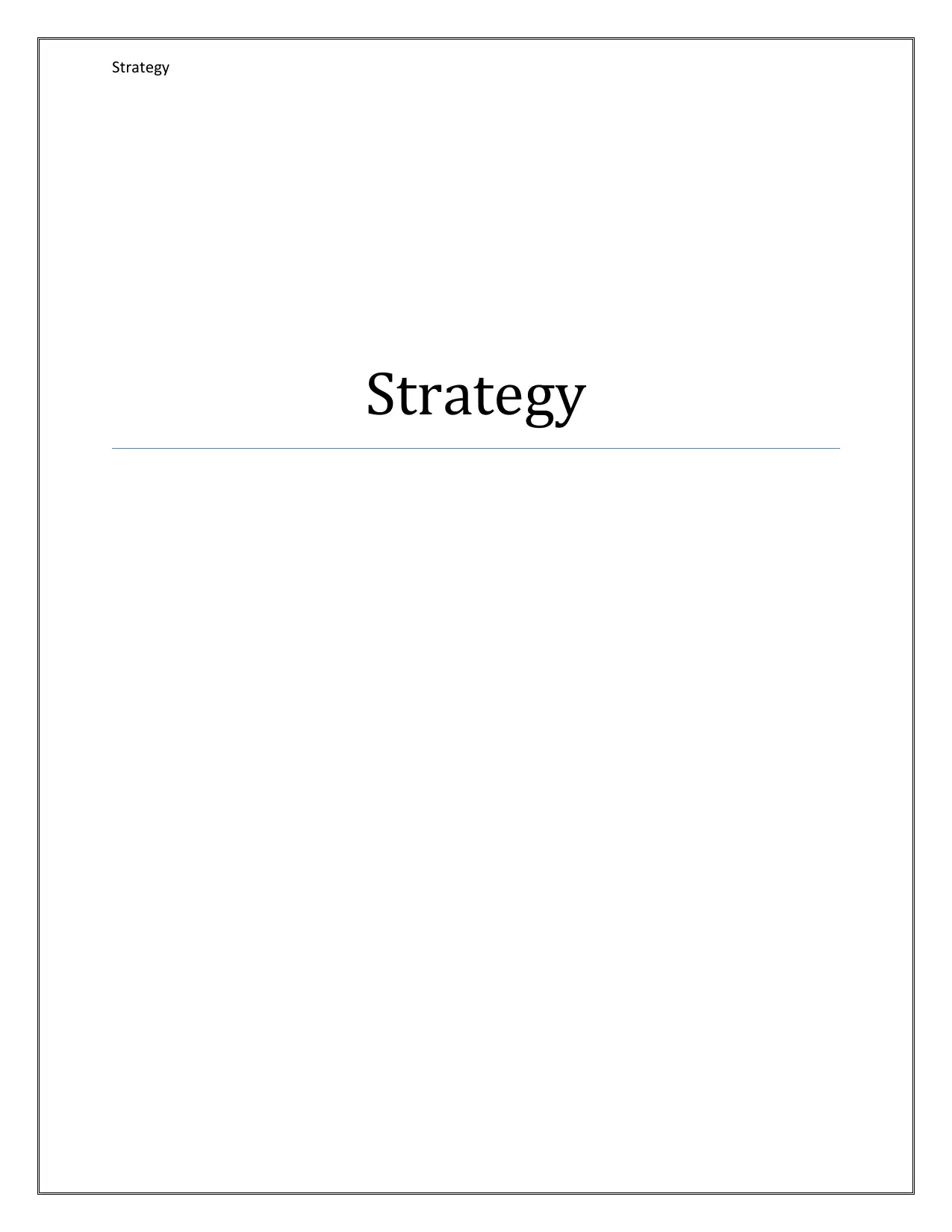
Strategy
Strategy
Strategy
Paraphrase This Document
Need a fresh take? Get an instant paraphrase of this document with our AI Paraphraser
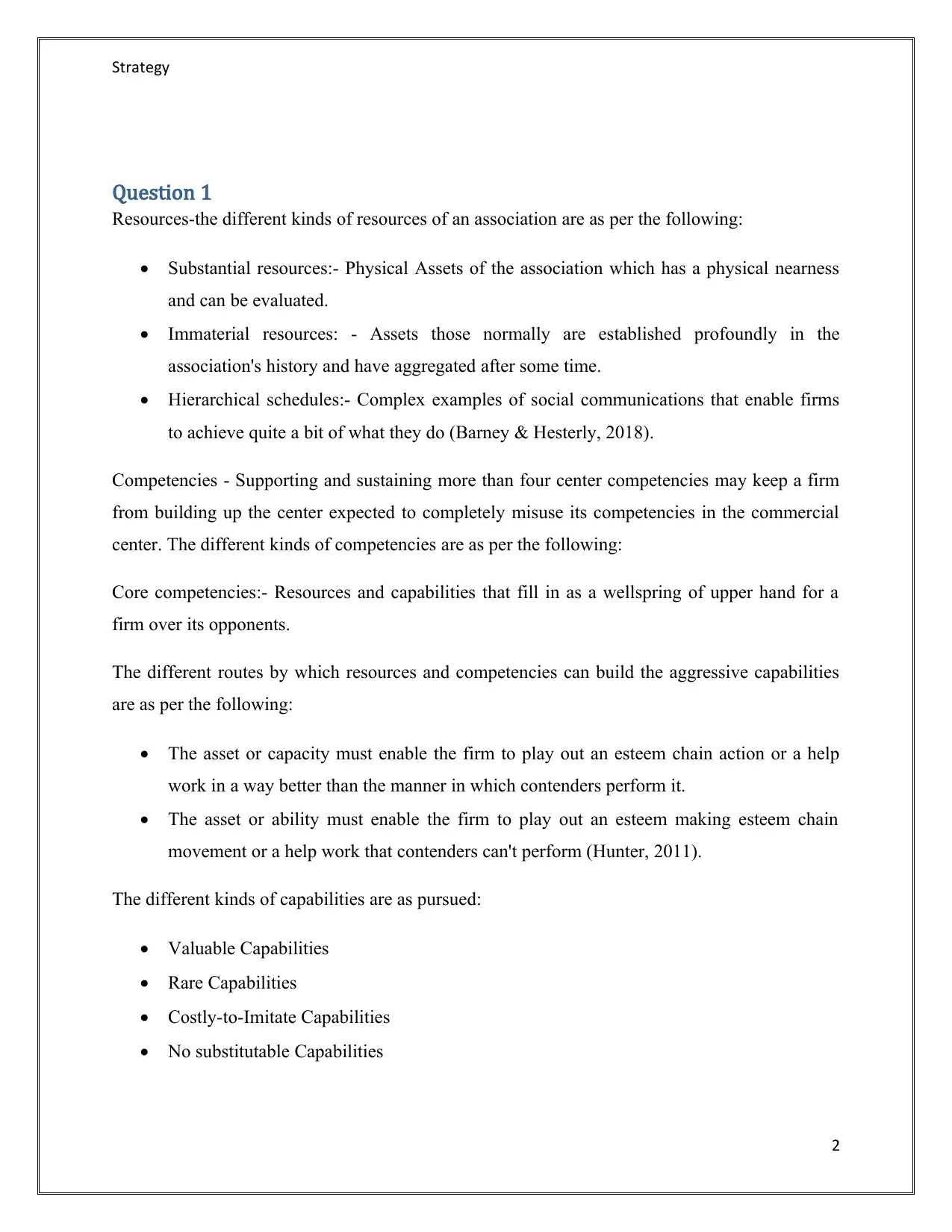
Strategy
Question 1
Resources-the different kinds of resources of an association are as per the following:
Substantial resources:- Physical Assets of the association which has a physical nearness
and can be evaluated.
Immaterial resources: - Assets those normally are established profoundly in the
association's history and have aggregated after some time.
Hierarchical schedules:- Complex examples of social communications that enable firms
to achieve quite a bit of what they do (Barney & Hesterly, 2018).
Competencies - Supporting and sustaining more than four center competencies may keep a firm
from building up the center expected to completely misuse its competencies in the commercial
center. The different kinds of competencies are as per the following:
Core competencies:- Resources and capabilities that fill in as a wellspring of upper hand for a
firm over its opponents.
The different routes by which resources and competencies can build the aggressive capabilities
are as per the following:
The asset or capacity must enable the firm to play out an esteem chain action or a help
work in a way better than the manner in which contenders perform it.
The asset or ability must enable the firm to play out an esteem making esteem chain
movement or a help work that contenders can't perform (Hunter, 2011).
The different kinds of capabilities are as pursued:
Valuable Capabilities
Rare Capabilities
Costly-to-Imitate Capabilities
No substitutable Capabilities
2
Question 1
Resources-the different kinds of resources of an association are as per the following:
Substantial resources:- Physical Assets of the association which has a physical nearness
and can be evaluated.
Immaterial resources: - Assets those normally are established profoundly in the
association's history and have aggregated after some time.
Hierarchical schedules:- Complex examples of social communications that enable firms
to achieve quite a bit of what they do (Barney & Hesterly, 2018).
Competencies - Supporting and sustaining more than four center competencies may keep a firm
from building up the center expected to completely misuse its competencies in the commercial
center. The different kinds of competencies are as per the following:
Core competencies:- Resources and capabilities that fill in as a wellspring of upper hand for a
firm over its opponents.
The different routes by which resources and competencies can build the aggressive capabilities
are as per the following:
The asset or capacity must enable the firm to play out an esteem chain action or a help
work in a way better than the manner in which contenders perform it.
The asset or ability must enable the firm to play out an esteem making esteem chain
movement or a help work that contenders can't perform (Hunter, 2011).
The different kinds of capabilities are as pursued:
Valuable Capabilities
Rare Capabilities
Costly-to-Imitate Capabilities
No substitutable Capabilities
2
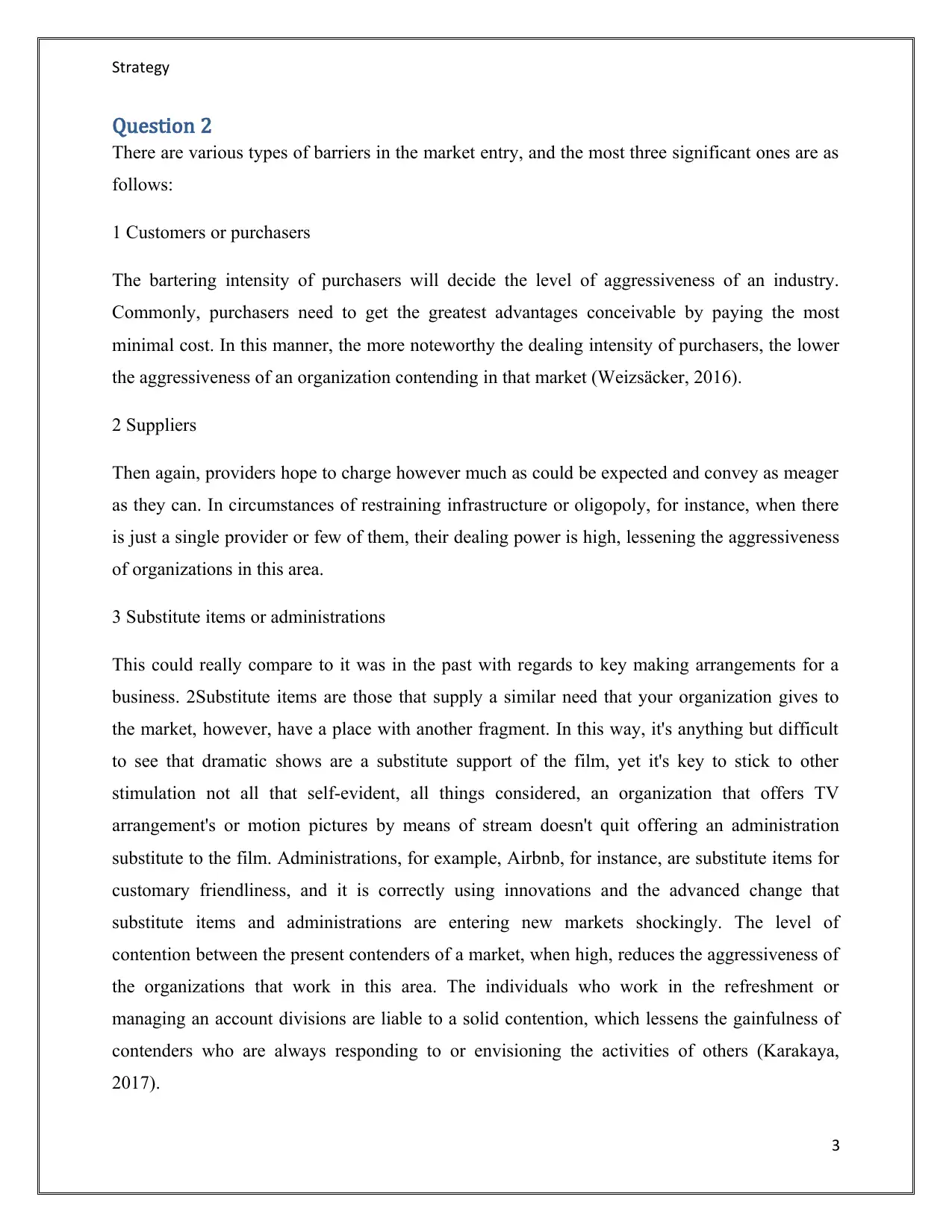
Strategy
Question 2
There are various types of barriers in the market entry, and the most three significant ones are as
follows:
1 Customers or purchasers
The bartering intensity of purchasers will decide the level of aggressiveness of an industry.
Commonly, purchasers need to get the greatest advantages conceivable by paying the most
minimal cost. In this manner, the more noteworthy the dealing intensity of purchasers, the lower
the aggressiveness of an organization contending in that market (Weizsäcker, 2016).
2 Suppliers
Then again, providers hope to charge however much as could be expected and convey as meager
as they can. In circumstances of restraining infrastructure or oligopoly, for instance, when there
is just a single provider or few of them, their dealing power is high, lessening the aggressiveness
of organizations in this area.
3 Substitute items or administrations
This could really compare to it was in the past with regards to key making arrangements for a
business. 2Substitute items are those that supply a similar need that your organization gives to
the market, however, have a place with another fragment. In this way, it's anything but difficult
to see that dramatic shows are a substitute support of the film, yet it's key to stick to other
stimulation not all that self-evident, all things considered, an organization that offers TV
arrangement's or motion pictures by means of stream doesn't quit offering an administration
substitute to the film. Administrations, for example, Airbnb, for instance, are substitute items for
customary friendliness, and it is correctly using innovations and the advanced change that
substitute items and administrations are entering new markets shockingly. The level of
contention between the present contenders of a market, when high, reduces the aggressiveness of
the organizations that work in this area. The individuals who work in the refreshment or
managing an account divisions are liable to a solid contention, which lessens the gainfulness of
contenders who are always responding to or envisioning the activities of others (Karakaya,
2017).
3
Question 2
There are various types of barriers in the market entry, and the most three significant ones are as
follows:
1 Customers or purchasers
The bartering intensity of purchasers will decide the level of aggressiveness of an industry.
Commonly, purchasers need to get the greatest advantages conceivable by paying the most
minimal cost. In this manner, the more noteworthy the dealing intensity of purchasers, the lower
the aggressiveness of an organization contending in that market (Weizsäcker, 2016).
2 Suppliers
Then again, providers hope to charge however much as could be expected and convey as meager
as they can. In circumstances of restraining infrastructure or oligopoly, for instance, when there
is just a single provider or few of them, their dealing power is high, lessening the aggressiveness
of organizations in this area.
3 Substitute items or administrations
This could really compare to it was in the past with regards to key making arrangements for a
business. 2Substitute items are those that supply a similar need that your organization gives to
the market, however, have a place with another fragment. In this way, it's anything but difficult
to see that dramatic shows are a substitute support of the film, yet it's key to stick to other
stimulation not all that self-evident, all things considered, an organization that offers TV
arrangement's or motion pictures by means of stream doesn't quit offering an administration
substitute to the film. Administrations, for example, Airbnb, for instance, are substitute items for
customary friendliness, and it is correctly using innovations and the advanced change that
substitute items and administrations are entering new markets shockingly. The level of
contention between the present contenders of a market, when high, reduces the aggressiveness of
the organizations that work in this area. The individuals who work in the refreshment or
managing an account divisions are liable to a solid contention, which lessens the gainfulness of
contenders who are always responding to or envisioning the activities of others (Karakaya,
2017).
3
⊘ This is a preview!⊘
Do you want full access?
Subscribe today to unlock all pages.

Trusted by 1+ million students worldwide
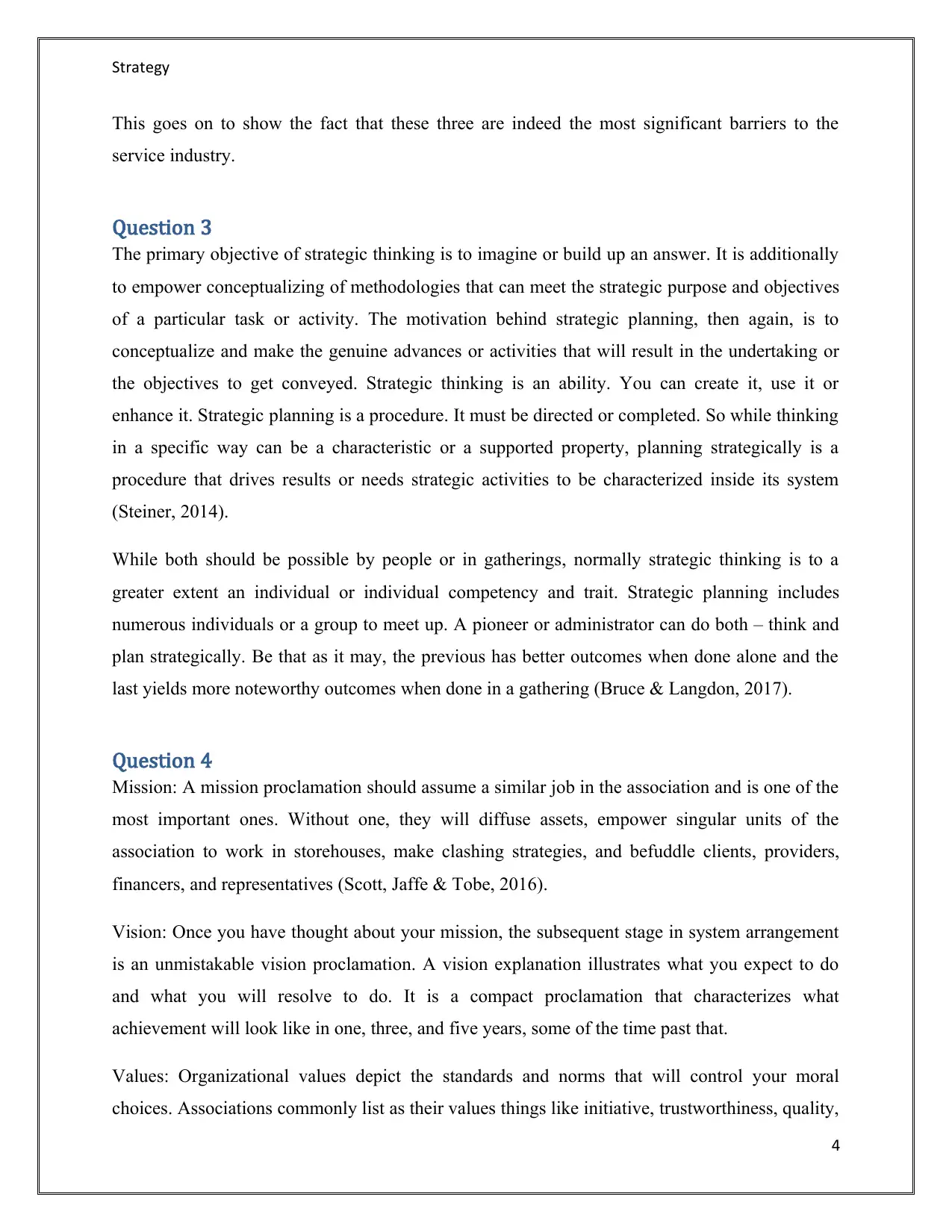
Strategy
This goes on to show the fact that these three are indeed the most significant barriers to the
service industry.
Question 3
The primary objective of strategic thinking is to imagine or build up an answer. It is additionally
to empower conceptualizing of methodologies that can meet the strategic purpose and objectives
of a particular task or activity. The motivation behind strategic planning, then again, is to
conceptualize and make the genuine advances or activities that will result in the undertaking or
the objectives to get conveyed. Strategic thinking is an ability. You can create it, use it or
enhance it. Strategic planning is a procedure. It must be directed or completed. So while thinking
in a specific way can be a characteristic or a supported property, planning strategically is a
procedure that drives results or needs strategic activities to be characterized inside its system
(Steiner, 2014).
While both should be possible by people or in gatherings, normally strategic thinking is to a
greater extent an individual or individual competency and trait. Strategic planning includes
numerous individuals or a group to meet up. A pioneer or administrator can do both – think and
plan strategically. Be that as it may, the previous has better outcomes when done alone and the
last yields more noteworthy outcomes when done in a gathering (Bruce & Langdon, 2017).
Question 4
Mission: A mission proclamation should assume a similar job in the association and is one of the
most important ones. Without one, they will diffuse assets, empower singular units of the
association to work in storehouses, make clashing strategies, and befuddle clients, providers,
financers, and representatives (Scott, Jaffe & Tobe, 2016).
Vision: Once you have thought about your mission, the subsequent stage in system arrangement
is an unmistakable vision proclamation. A vision explanation illustrates what you expect to do
and what you will resolve to do. It is a compact proclamation that characterizes what
achievement will look like in one, three, and five years, some of the time past that.
Values: Organizational values depict the standards and norms that will control your moral
choices. Associations commonly list as their values things like initiative, trustworthiness, quality,
4
This goes on to show the fact that these three are indeed the most significant barriers to the
service industry.
Question 3
The primary objective of strategic thinking is to imagine or build up an answer. It is additionally
to empower conceptualizing of methodologies that can meet the strategic purpose and objectives
of a particular task or activity. The motivation behind strategic planning, then again, is to
conceptualize and make the genuine advances or activities that will result in the undertaking or
the objectives to get conveyed. Strategic thinking is an ability. You can create it, use it or
enhance it. Strategic planning is a procedure. It must be directed or completed. So while thinking
in a specific way can be a characteristic or a supported property, planning strategically is a
procedure that drives results or needs strategic activities to be characterized inside its system
(Steiner, 2014).
While both should be possible by people or in gatherings, normally strategic thinking is to a
greater extent an individual or individual competency and trait. Strategic planning includes
numerous individuals or a group to meet up. A pioneer or administrator can do both – think and
plan strategically. Be that as it may, the previous has better outcomes when done alone and the
last yields more noteworthy outcomes when done in a gathering (Bruce & Langdon, 2017).
Question 4
Mission: A mission proclamation should assume a similar job in the association and is one of the
most important ones. Without one, they will diffuse assets, empower singular units of the
association to work in storehouses, make clashing strategies, and befuddle clients, providers,
financers, and representatives (Scott, Jaffe & Tobe, 2016).
Vision: Once you have thought about your mission, the subsequent stage in system arrangement
is an unmistakable vision proclamation. A vision explanation illustrates what you expect to do
and what you will resolve to do. It is a compact proclamation that characterizes what
achievement will look like in one, three, and five years, some of the time past that.
Values: Organizational values depict the standards and norms that will control your moral
choices. Associations commonly list as their values things like initiative, trustworthiness, quality,
4
Paraphrase This Document
Need a fresh take? Get an instant paraphrase of this document with our AI Paraphraser
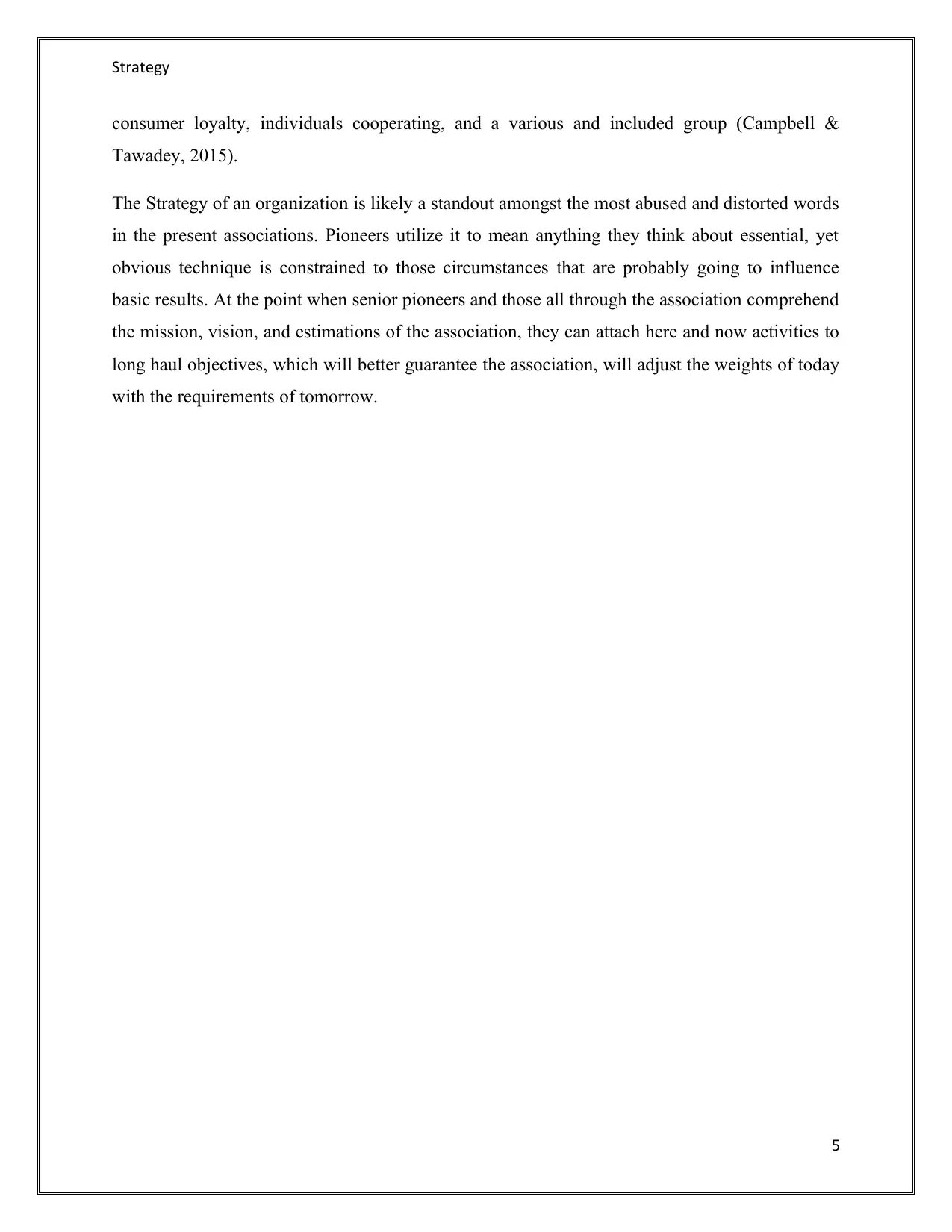
Strategy
consumer loyalty, individuals cooperating, and a various and included group (Campbell &
Tawadey, 2015).
The Strategy of an organization is likely a standout amongst the most abused and distorted words
in the present associations. Pioneers utilize it to mean anything they think about essential, yet
obvious technique is constrained to those circumstances that are probably going to influence
basic results. At the point when senior pioneers and those all through the association comprehend
the mission, vision, and estimations of the association, they can attach here and now activities to
long haul objectives, which will better guarantee the association, will adjust the weights of today
with the requirements of tomorrow.
5
consumer loyalty, individuals cooperating, and a various and included group (Campbell &
Tawadey, 2015).
The Strategy of an organization is likely a standout amongst the most abused and distorted words
in the present associations. Pioneers utilize it to mean anything they think about essential, yet
obvious technique is constrained to those circumstances that are probably going to influence
basic results. At the point when senior pioneers and those all through the association comprehend
the mission, vision, and estimations of the association, they can attach here and now activities to
long haul objectives, which will better guarantee the association, will adjust the weights of today
with the requirements of tomorrow.
5
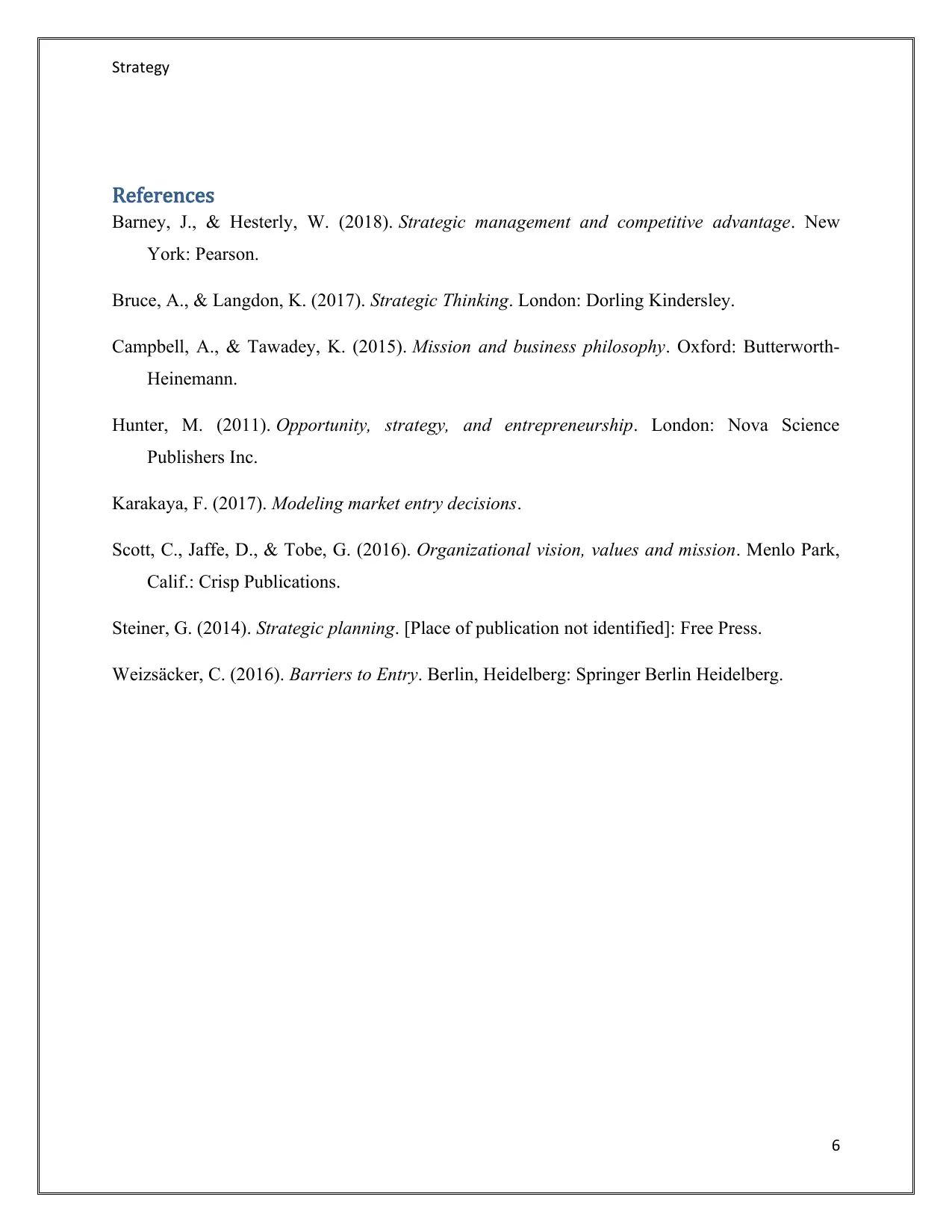
Strategy
References
Barney, J., & Hesterly, W. (2018). Strategic management and competitive advantage. New
York: Pearson.
Bruce, A., & Langdon, K. (2017). Strategic Thinking. London: Dorling Kindersley.
Campbell, A., & Tawadey, K. (2015). Mission and business philosophy. Oxford: Butterworth-
Heinemann.
Hunter, M. (2011). Opportunity, strategy, and entrepreneurship. London: Nova Science
Publishers Inc.
Karakaya, F. (2017). Modeling market entry decisions.
Scott, C., Jaffe, D., & Tobe, G. (2016). Organizational vision, values and mission. Menlo Park,
Calif.: Crisp Publications.
Steiner, G. (2014). Strategic planning. [Place of publication not identified]: Free Press.
Weizsäcker, C. (2016). Barriers to Entry. Berlin, Heidelberg: Springer Berlin Heidelberg.
6
References
Barney, J., & Hesterly, W. (2018). Strategic management and competitive advantage. New
York: Pearson.
Bruce, A., & Langdon, K. (2017). Strategic Thinking. London: Dorling Kindersley.
Campbell, A., & Tawadey, K. (2015). Mission and business philosophy. Oxford: Butterworth-
Heinemann.
Hunter, M. (2011). Opportunity, strategy, and entrepreneurship. London: Nova Science
Publishers Inc.
Karakaya, F. (2017). Modeling market entry decisions.
Scott, C., Jaffe, D., & Tobe, G. (2016). Organizational vision, values and mission. Menlo Park,
Calif.: Crisp Publications.
Steiner, G. (2014). Strategic planning. [Place of publication not identified]: Free Press.
Weizsäcker, C. (2016). Barriers to Entry. Berlin, Heidelberg: Springer Berlin Heidelberg.
6
⊘ This is a preview!⊘
Do you want full access?
Subscribe today to unlock all pages.

Trusted by 1+ million students worldwide
1 out of 6
Related Documents
Your All-in-One AI-Powered Toolkit for Academic Success.
+13062052269
info@desklib.com
Available 24*7 on WhatsApp / Email
![[object Object]](/_next/static/media/star-bottom.7253800d.svg)
Unlock your academic potential
Copyright © 2020–2025 A2Z Services. All Rights Reserved. Developed and managed by ZUCOL.




